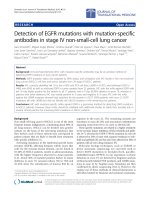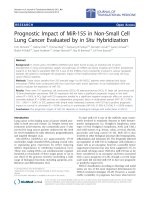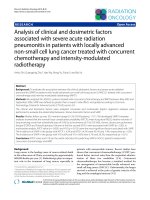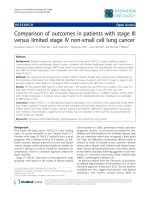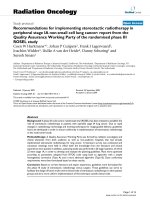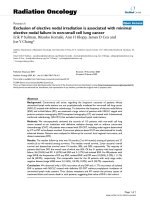Evaluation of the operation outcomes of non small cell lung cancer stage I - IIIA in Hanoi Medical University Hospital
Bạn đang xem bản rút gọn của tài liệu. Xem và tải ngay bản đầy đủ của tài liệu tại đây (134.84 KB, 4 trang )
Journal of military pharmaco-medicine no1-2019
EVALUATION OF THE OPERATION OUTCOMES
OF NON-SMALL CELL LUNG CANCER STAGE I - IIIA
IN HANOI MEDICAL UNIVERSITY HOSPITAL
Le Van Quang1; Trinh Le Huy1; Mai Thi Kim Ngan1
Nguyen Van Dang1; Nguyen Xuan Hau1
SUMMARY
Objectives: To evaluate the operation outcomes of stage I - IIIA non-small cell lung cancer
patients in Hanoi Medical University Hospital. Subjects and methods: The retrospective descriptive
study of 30 non-small cell lung cancer patients staged I to IIIA. Results: Lobectomy was 96.7%,
lung excision was only 3.3%. The average of operating time was 3.4 ± 0.8 hours. The blood loss
during operation was 200 ± 25 mL. Postoperative complications: 6.6% (3.3% surgical bleeding,
3.3% subcutaneous emphysema). The average hospitalization length was 8 ± 1.5 days. The duration
of postoperative analgesia was 7 ± 1.5 days. The disease free survival rates at 12, 24, 36
months: 86%, 76%, 66%. The overall survival at 12, 24, 36 months: 100%, 93%, 86.6%. Conclusion:
Surgery for non-small cell lung cancer stage I - IIIA in the Oncology and Palliative Care Department,
Hanoi Medical University Hospital had a good surgical and oncological results.
* Keywords: Non-small cell lung cancer; Stage I - IIIA; Surgical outcome.
INTRODUCTION
Lung cancer is the most common
cancer in men and is the leading cause of
death in cancer patient. Lung cancer has
a poor prognosis because of rapid
progression, early metastasis and late
diagnosis. Therefore, the indication of
surgery is very limited. However, in recent
years, the rapid development of diagnostic
techniques has helped to detect the
disease at earlier stages, so that the
patients can be good candidates for surgery.
Surgery for lung cancer at the
Department of Oncology and Palliative
Care of Hanoi Medical University
Hospital has been done since 2009. The
primiliary results are promising. However,
these results must be accurately and
scientifically assessed by a strict study.
Therefore, we conducted this research:
Evaluation of the operation outcome of
non-small cell lung cancer staged I - IIIA
in Hanoi Medical University Hospital.
SUBJECTS AND METHODS
1. Subjects.
* Inclusion criteria:
- Pathologically diagnosed as non-small
cell lung cancer.
- Staged as IA, IB, IIA, IIB and IIIA
according to UICC and AJCC (2010)
classification.
1. Hanoi Medical University Hospital
Corresponding author: Trinh Le Huy ()
Date received: 20/10/2018
Date accepted: 11/12/2018
74
Journal of military pharmaco-medicine no1-2019
- Performed surgery with or without
other combined treatments.
- Medical report contains sufficient and
accurate information.
* Surgical complications:
- No other cancer.
* Exclusion criteria: not suitable for
inclusion criteria.
2. Methods.
- The retrospective, descriptive study.
- The procedure is as follows:
Evaluation of early results of surgery
for non-small cell lung cancer:
+ Surgical method.
+ Time for operation.
+ Blood loss during operation.
+ Common surgical complications such
as: Length of post-operative hospitalization;
duration of post-operative analgesia.
- Evaluate the oncological outcome:
Disease free survival (DFS) and overall
survival (OS).
* Data processing: Data was processed
by software SPSS 20.0.
RESULTS AND DISCUSSION
In our study, the incidence of lobectomy
was 96.7%. The rate of bi-lobectomy was 3.3%.
There was no case of pneumonectomy.
Table 1: Operative time and the amount
of blood loss.
Minimum Maximum
Operative
(hours)
time
Blood loss during
operation (mL)
was 2.4 hours [4]. Operative time in study
by Whitson was 3.5 hours [5]. Shiraishi
also lost an average of 3.5 hours per lung
operation.
Average
2.8
4.2
3.4 ± 0.8
150
250
200 ± 25
Our results were similar to that reported
by other authors [3, 4, 5, 6]. Sutoro reported:
his operative time for lung cancer in 2010
Post-operative bleeding: 1 patient (3.3%).
Arcording to Sutoro [6], open surgery had
10 post-operative bleeding patients
accounted for 1.5% [4]. The postoperative
bleeding rate of Whitson’s study [4] was
4% (24 patients) [5]. In our study, 1 patient
(Le Quang K - 21th number) had post-operative
bleeding on the first postoperative day.
After examination, we detected bleeding
from the incision. Patient was stitched again.
The following days, the patient was stable
and was discharged on the 10th day.
Subcutaneous emphysema: 1 patient
(3.3%). Nguyen Hoa Binh's study on
92 patients also included 2 cases of
prolonged pneumothorax. In our study,
none of the patients had prolonged
pneumothorax. Probably, we had experience
in stitching closure of the windpipe
remaining. Only 1 patient showed
subcutaneous emphysema on the second
postoperative day. The level of gas was
mild and self-healing after 5 days.
* Length of hospitalization:
Length of post-operative hospitalization:
the shortest: 7 days, the longest: 12 days,
average: 8 ± 1.5 days. Our study also
found that the post-operative hospitalization
did not exceed 12 days, the shortest time
was comparable to other studies in our
country [1, 4].
* Duration of post-operative analgesia:
The shortest: 5 days, the longest: 10 days;
average: 7 ± 1.5 days.
75
Journal of military pharmaco-medicine no1-2019
Figure 1: DFS.
The rate of DFS were 86%, 76%, 66% at 12, 24, 36 months, respectively. When
stratified by stage, the rate of DFS at 12, 24, 36 months in stage I group was 93%,
86%, 80%, in stage II group were 88%, 77%, 73% and in stage IIIA group were only
71%, 50%, 33%, respectively. Our results were comparable to those of other authors in
Vietnam and foreign country [1, 2, 4].
Figure 2: OS.
76
Journal of military pharmaco-medicine no1-2019
The rate of OS at 12, 24, 36 months of
all stages were: 100%, 93%, 86.6%.
Stratified by stage, this rate in stage I, II
and IIIA groups were 100%, 100%, 93%,
100%, 88%, 77% and 100%, 83%, 50%,
respectively. Compared to other studies
in Vietnam and foreign countries, our OS
rate was similar. Nguyen Khac Kiem's study
recorded OS rates at 12, 24, 36 months
were, 89%, 73%, 67%, respectively,
mean survival was 27.19 ± 9.5 months
(the shortest was 1 month and the longest
was 43 months) [2].
According to Zhou QH’s study (2006),
the results of surgery for 248 patients with
lung cancer, recorded that rate of 1-year
OS was 78.6%, 3-year OS was 60.5%,
5-year OS was 32.7%, 10-year OS was
20.9%. The OS rate of Zhou’s study was
inferior than of ours because many his
patients were in later stage [7]
Fukinos et al (2011) studied 216 patients
and found that in the lobectomy group,
5-year OS was 55.6% whereas in the
bilobectomy and pneumonectomy group,
this rate was 27.7% [8].
CONCLUSIONS
University of Medicine
Hochiminh City. 2015.
and
Pharmacy.
2. Nguyen Khac Kiem. Study node mapbased lymphadenectomy in I, II, IIIA nonsmall-cell lung cancer surgery. Doctor of
Medicine. Hanoi Medical University. 2016.
3. Gopaldas R.R, Faisal G. Bakaeen,
Tam K Dao et al. Video-assisted thoracoscopic
versus open thoracotomy lobectomy in a
cohort of 13.619 patients. Ann Thorac Surg.
2010, 89, pp.1563-1570.
4. Sutoro W.J, Mark S. Allen, Gail Darling
et al. Video-assiated thoracic surgery vs. open
lobectomy for lung cancer. A secondary
analysis of data from American College of
Surgeons Oncology Group Z0030 randomized,
double-blind, placebo-controlled trial. J Thorac
Cardiovasc Surg. 2010, 139, pp.976-983.
5. Whitson B, Rafael S. Andrade, Adam
Boettcher et al. Video-assisted thoracoscopic
surgery is more favorable than thoracotomy
for the resection of clinical stage and non-small
cell lung cancer. Ann Thorac Surg. 2007, 83,
pp.1965-1970.
6. Shiraishi T, Takayuki Shirakusa, Masafumi
Hiratsuka et al. Video-assisted thoracoscopic
lobectomy for C-T1N0M0 primary lung cancer:
Its impact on locoregional control. Ann Thorac
Surg. 2006, 82, pp.1021-1026.
REFERENCES
7. Zhou Q.H, Liu L.X, Wang Y, Zhang H.B
et al. Extended resection of the left atrium,
great vessels or both for locally advanced
lung cancer. An experience of 248 cases,
lung cancer. Journal of the International
Association for the study of lung cancer.
th
9 World Conference on Lung Cancer. Tokyo,
Japan. 2006, p.136.
1. Nguyen Hoang Binh. Assessment of the
feasibility and effectiveness of laparoscopic
surgery in pulmonary disease. Doctor of Medicine.
8. Fukinos, Fukata T, Hayashi E et al.
Lobectomy of the two or more lobes in patients
with lung cancer. 2011, 54 (3), pp.219-224.
Surgery for non-small cell lung cancer
stage I - III A in the in the Oncology and
Palliative Care Department, Hanoi Medical
University Hospital had promising surgical
and oncological results.
77
